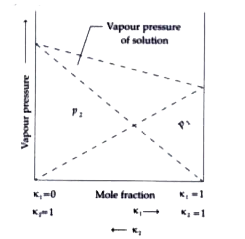Assertion:At equilibrium , vapour phase will be always rich in component which is more volatile
Reason : The composition of vapour phase in equilibrium with the solution is determined by the partial pressures of the components
If both assertion and reason are true and reason is the correct explanation of assertion
If both assertion and reason are true but reason is not the correct explanation of assertion.
If assertion is true but reason is false
If both assertion and reason are false
The correct Answer is:A
Topper's Solved these Questions
Similar Questions
When an ideal binary solution is in equilibrium with its vapour, molar ratio of the two components in the solution and in the vapur phase is :
View SolutionWhen an ideal binary solution is in equilibrium with its vapour, molar ratio of the two components in the solution and in the vapur phase is :
View Solution
Knowledge Check
Assertion: At equilibrium, vapour phase will not be always rich in component which is more volatile.
Reason: The composition of vapour phase in equilibrium with the solution is determined by the partial pressures of the components.AIf both assertion and reason are true and reason is the correct explanation of assertion.BIf both assertion and reason are true, but reason is not the correct explanation of assertion.CIf assertion is true, but reason is false.DIf both assertion and reason are falseAssertion (A) : The vapour phase is always richer in the component which is less volatile.
Reason (R) : The relative lowering of the vapour pressure of a solution is proportional to mole fraction of the solvent.ABoth Assertion (A) and Reason (R) are correct statements, and Reason (R) is the correct explanation of the Assertion (A).BBoth Assertion (A) and Reason (R) are correct statements, but Reason (R) is not the correct explanation of the Assertion (A).CAssertion (A) is correct, but Reason (R) is incorrect statement,DAssertion (A) is incorrect, but Reason (R) is correct statement.At equilibrium, more volatile component in the solution has
Ahigher vapour phase of that componentBlower vapour phase of that componentCBoth (1) and (2)DAbove options do not support the statement
Vapor pressure of a solution of Volatile components and composition of vapor: Consider a solution containing 738g of water and 253g of ethanol (C2H5OH) at 323K. At this temperature, the vapour pressure of pure ethanol is 0.292atm and the vapor pressure of pure water is 0.122atm. Calculate the vapour pressure of the solution and mole fraction of every component in vapour phase.
Strategy: First calculate the moles and the mole fraction of each component in the liquid solution. Then apply Raoult's law to each of the two volatile components to calculate their partial pressures. The total vapour pressure is the sum of the partial vapour pressures of the components and the mole fraction of a components in a gaseous mixture equals the ratio of its partial pressure to the total pressure.
View SolutionThe vapour pressure of two pure isomeric liquids X and Y are 200 torr and 100 torr respectively at a given temperature. Assuming a solution of these components to obey Raoults law, the mole fraction of component X in vapour phase in equilibrium with the solution containing equal amounts of X and Y, at the same temperature is :
View SolutionAt a certain temperature pure liquid A and liquid B have vapour pressure 10 and 37 torr respectively. For a certain ideal solution of A and B, the vapours in equilibrium with the liquid has the components A and B in the partial pressure ratio PA:PB=1:7. The mole fraction of A in the solution are:
View SolutionWhen an ideal binary solution is in equilibrium with its vapour, molar ratio of the two components in the solution and in the vapur phase is :
View SolutionRead the passage given below and answer the following questions :
Raoult's law states that for a solution of volatile liquids, the partial vapour pressure of each component of the solution is directly proportional to its mole fraction present in solution. Dalton's law of partial pressure states that the total pressure Ptotal over the solution phase in the container will be the sum of the partial pressures of the components of the solution and is given as:
Ptotal= P1+ P2

Which of the following aqueous solutions should have the highest boiling point ?
View Solution
